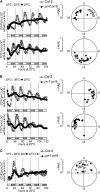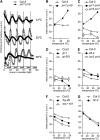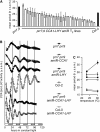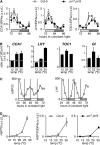The role of the Arabidopsis morning loop components CCA1, LHY, PRR7, and PRR9 in temperature compensation
- PMID: 21098730
- PMCID: PMC3015110
- DOI: 10.1105/tpc.110.079087
The role of the Arabidopsis morning loop components CCA1, LHY, PRR7, and PRR9 in temperature compensation
Abstract
A defining, yet poorly understood characteristic of the circadian clock is that it is buffered against changes in temperature such that the period length is relatively constant across a range of physiologically relevant temperatures. We describe here the role of PSEUDO RESPONSE REGULATOR7 (PRR7) and PRR9 in temperature compensation. The Arabidopsis thaliana circadian oscillator comprises a series of interlocking feedback loops, and PRR7 and PRR9 function in the morning loop. The prr7 prr9 double mutant displays a unique phenotype that has not been observed before in other Arabidopsis clock mutants. In the prr7 prr9 mutant, the effects of temperature are overcompensated, apparently due to hyperactivation of the transcription factors CIRCADIAN CLOCK ASSOCIATED1 (CCA1) and LATE ELONGATED HYPOCOTYL (LHY). Inactivation of CCA1 and LHY fully suppresses the overcompensation defects of prr7 prr9 mutants and rescues their long period phenotype. Overcompensation in prr7 prr9 mutants does not rely on FLOWERING LOCUS C, a previously identified gene required for temperature compensation. Together, our results reveal a role of PRR7 and PRR9 in regulating CCA1 and LHY activities in response to ambient temperature.
Figures






Comment in
-
Temperature compensation of the circadian clock: a role for the morning loop.Plant Cell. 2010 Nov;22(11):3506. doi: 10.1105/tpc.110.221111. Epub 2010 Nov 23. Plant Cell. 2010. PMID: 21098732 Free PMC article. No abstract available.
Similar articles
-
PSEUDO-RESPONSE REGULATORS 9, 7, and 5 are transcriptional repressors in the Arabidopsis circadian clock.Plant Cell. 2010 Mar;22(3):594-605. doi: 10.1105/tpc.109.072892. Epub 2010 Mar 16. Plant Cell. 2010. PMID: 20233950 Free PMC article.
-
A genetic study of the Arabidopsis circadian clock with reference to the TIMING OF CAB EXPRESSION 1 (TOC1) gene.Plant Cell Physiol. 2009 Feb;50(2):290-303. doi: 10.1093/pcp/pcn198. Epub 2008 Dec 19. Plant Cell Physiol. 2009. PMID: 19098071
-
Overlapping and distinct roles of PRR7 and PRR9 in the Arabidopsis circadian clock.Curr Biol. 2005 Jan 11;15(1):47-54. doi: 10.1016/j.cub.2004.12.067. Curr Biol. 2005. PMID: 15649364
-
MYB transcription factors in the Arabidopsis circadian clock.J Exp Bot. 2002 Jul;53(374):1551-7. doi: 10.1093/jxb/erf027. J Exp Bot. 2002. PMID: 12096093 Review.
-
Unlocking allelic variation in circadian clock genes to develop environmentally robust and productive crops.Planta. 2024 Feb 22;259(4):72. doi: 10.1007/s00425-023-04324-8. Planta. 2024. PMID: 38386103 Free PMC article. Review.
Cited by
-
Aschoff's rule on circadian rhythms orchestrated by blue light sensor CRY2 and clock component PRR9.Nat Commun. 2022 Oct 5;13(1):5869. doi: 10.1038/s41467-022-33568-3. Nat Commun. 2022. PMID: 36198686 Free PMC article.
-
Compensatory Mutations in GI and ZTL May Modulate Temperature Compensation in the Circadian Clock.Plant Physiol. 2020 Feb;182(2):1130-1141. doi: 10.1104/pp.19.01120. Epub 2019 Nov 18. Plant Physiol. 2020. PMID: 31740505 Free PMC article.
-
Plant clock modifications for adapting flowering time to local environments.Plant Physiol. 2022 Sep 28;190(2):952-967. doi: 10.1093/plphys/kiac107. Plant Physiol. 2022. PMID: 35266545 Free PMC article.
-
Genome-Wide Comparative Analysis of Flowering-Related Genes in Arabidopsis, Wheat, and Barley.Int J Plant Genomics. 2015;2015:874361. doi: 10.1155/2015/874361. Epub 2015 Sep 7. Int J Plant Genomics. 2015. PMID: 26435710 Free PMC article.
-
The interplay between the circadian clock and abiotic stress responses mediated by ABF3 and CCA1/LHY.Proc Natl Acad Sci U S A. 2024 Feb 13;121(7):e2316825121. doi: 10.1073/pnas.2316825121. Epub 2024 Feb 6. Proc Natl Acad Sci U S A. 2024. PMID: 38319968 Free PMC article.
References
Publication types
MeSH terms
Substances
LinkOut - more resources
Full Text Sources
Molecular Biology Databases

